
Polish
Surface Morphology of Diamond (SUMODI)
Goal
The objective of this project is the automation of polish grading. Next
to the evaluation of polish lines also a range of other surface
defects needs to be detected. The final goal is a quantification
of the polish in an objective and standardized manner.
Description
The polish grading is done manually with the aid of a loupe 10x or
microscope. For the polisher the loupe is not the only aid to
evaluate polish lines during polishing. The
Avalon device visualizes the
polishing lines of a facet being polished. Both polishers and graders
can evaluate polish in a different way because of the different viewing conditions. This can lead to
inconsistency in the evaluation of the polish grade and
discussions between graders and polishers. Intelligent automation can
provide accurate and consistent information on the polish grade.
The nessecary equipment must be developed
for both polishers and graders.
Current status
The first part of the project concentrated on the nature of all the defects influencing the polish.
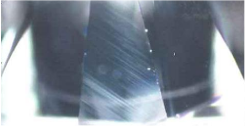 In
the picture on the left we see an image of polishing lines on a pavilion half. Heavy
polishing lines are clearly visible as a pattern of white stripes under
grazing light. The polish grade will depend on the visibility of the
polishing lines
In
the picture on the left we see an image of polishing lines on a pavilion half. Heavy
polishing lines are clearly visible as a pattern of white stripes under
grazing light. The polish grade will depend on the visibility of the
polishing lines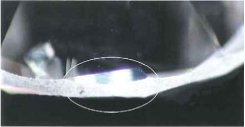 The
next defect is extra facets. These appear by accident or to mask
remainders of the rough diamond. In both cases they lead to a downgrade
of the polish.
The
next defect is extra facets. These appear by accident or to mask
remainders of the rough diamond. In both cases they lead to a downgrade
of the polish.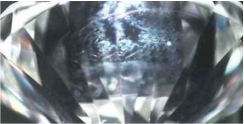 Burnmarks
have the look of faint oil stains on the facet. The visibility can
increase looking at the defect through the diamond from the opposite
side. The cause of burnmarks is oxidation of the surface due to
overheating the diamond during polishing.
Burnmarks
have the look of faint oil stains on the facet. The visibility can
increase looking at the defect through the diamond from the opposite
side. The cause of burnmarks is oxidation of the surface due to
overheating the diamond during polishing.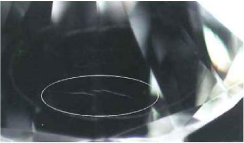 Fine
Scratches can lead to a downgrade of the polish grade. This depends on
the visibility. The grading rules state that the grading has to been
done looking at the diamond from the crown side with a loupe 10x.
Graders often tend to look through the pavilion side at scratches on the
table. This can lead to discussions between grading labs and polishers
about the correct polish grade.
Fine
Scratches can lead to a downgrade of the polish grade. This depends on
the visibility. The grading rules state that the grading has to been
done looking at the diamond from the crown side with a loupe 10x.
Graders often tend to look through the pavilion side at scratches on the
table. This can lead to discussions between grading labs and polishers
about the correct polish grade.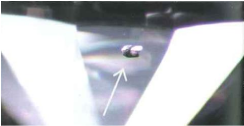 Small
pits in the facet are judged by there visibility. Some common reasons for
pits are damages after polishing, left overs from rough, or break out of
micro crystals.
Small
pits in the facet are judged by there visibility. Some common reasons for
pits are damages after polishing, left overs from rough, or break out of
micro crystals.
There is a solution for visualizing polish lines, Avalon, but there is no measure for the visibility of these lines. This means that production time can increase, trying to remove details beyond visibility. The challenge of this project was to safeguard the quality but decrease production time per diamond.
The first study tried to capture all classical parameters for surface roughness as being used in mechanical engineering. To measure the surface roughness we used a PSI device (Phase Shifting Interferometry) at VITO. The conclusion of this first test was disappointing, there was no link between human inspection and classical surface roughness parameters. Further investigations were focused on the mathematical relation between Avalon images and height data from the PSI. This finally leaded to a measure for the visibility of polishing lines calculated out of improved Avalon images. These results gave birth to a new device, AvalonPlus.
AvalonPlus, the ultimate Avalon
Compared to Avalon, AvalonPlus has:
- A sharper, high resolution, image
- Less internal reflections disturbing the image
- Build in dust avoiding measures
- A color coded evaluation of the visibility grade of polishing lines
- Extra facet measurements to improve production
- A sharper, high resolution, image
- Less internal reflections disturbing the image
- Build in dust avoiding measures
- A color coded evaluation of the visibility grade of polishing lines
- Extra facet measurements to improve production
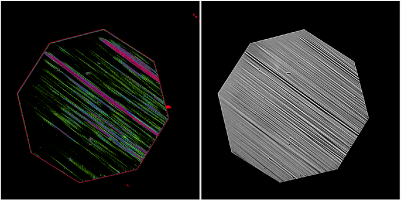
No color = line invisible, green to red = slightly visible to clearly visible
At this moment the prototype of AvalonPlus is used to gather data in cooperation with the diamond industry. The aim is to create a standard polish grade combined with objective and consistent measurements used by industry and labs. Transparent, measurable, rules for polish are a benefit for the whole diamond sector and the consumer.
Contact
Everything you would like to know about Surface Morphology of Diamond
(SUMODI)...Dr. Peter ter Heerdt, WTOCD (Scientific and Technical Research Center for Diamond), Lier, Belgium.
Interested in a demo of AvalonPlus...
Erik Wanten, WTOCD (Scientific and Technical Research Center for Diamond), Lier, Belgium.